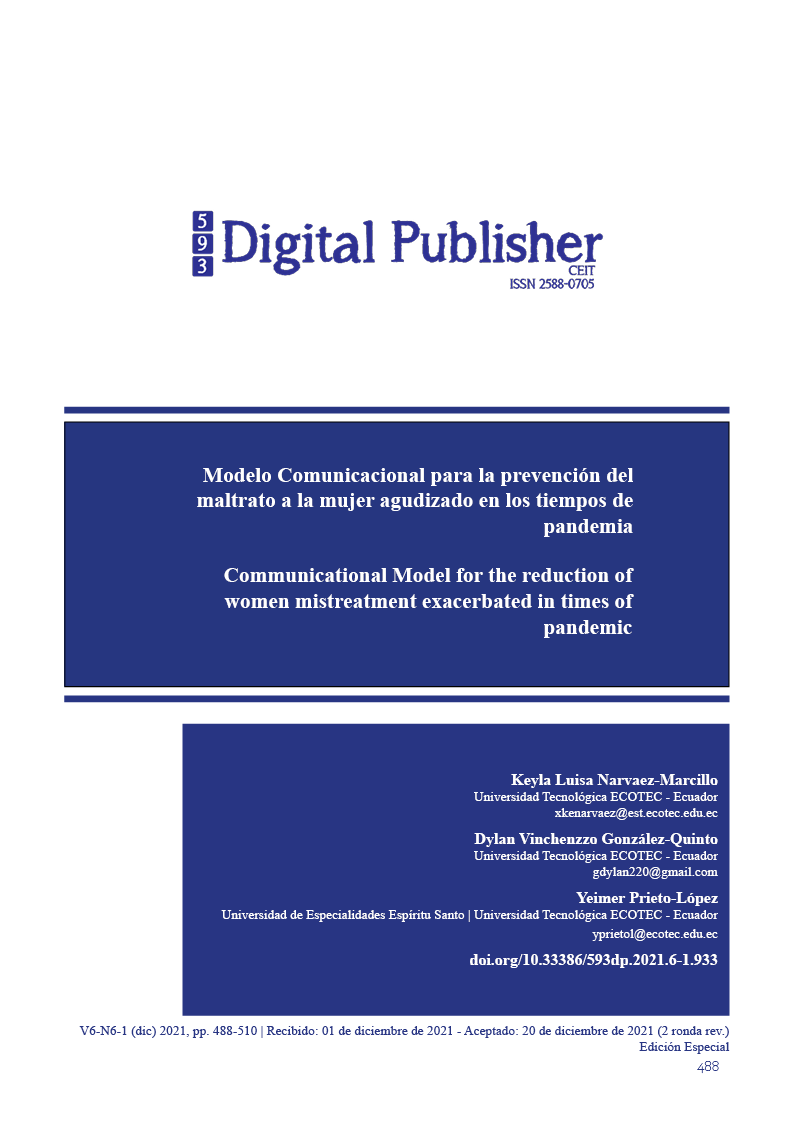Communicational Model for the reduction of women mistreatment exacerbated in times of pandemic
Main Article Content
Abstract
The acute problem a that the mistreatment of women has become in times of the pandemic against COVID-19 worldwide is no longer a secret, despite the fact that 2019 began and in which more than 90 countries were or are In confinement, it was not an impediment to unleash a mortal danger against women, the general increase in femicide, the increase in domestic gender violence against women, among others. Based on the last 12 months worldwide, a percentage of 243, 000, 000% of women, girls and adolescents between the ages of 15 to 49 abused has increased, turning this into a deadly, dark and second pandemic. (Phumzile Mlambo-Ngcuka, UN WOMEN, 2020).
Therefore, this research proposes to enhance information and knowledge towards women in general, using an effective communicational model such as Laswell, Lazarsfield, Hovloand and Lewin who evidenced the EOR (stimulus-organism-response) model, the same one that indicates who says the message, what channel it uses, for whom it is directed and what result it wants to obtain precisely (Galeano, 2002).
Apply preventive measures where it is effectively communicated that there are currently services that are essential for their help and prevention, mutual support for those affected and survivors, since when a woman shares her experience, she breaks the cycle, zero tolerance towards violence against women, in order to end this.
The present investigation is of a qualitative type, where the application of scientific methods has prevailed; such as: the historical-logical, the theoretical systematization, the analysis and the synthesis as part of it, a survey was carried out to experts and students of the subject. The objective of this research is to develop a preventive communication model against the mistreatment of women exacerbated in times of pandemic.
Downloads
Article Details

This work is licensed under a Creative Commons Attribution-NonCommercial-ShareAlike 4.0 International License.
1. Derechos de autor
Las obras que se publican en 593 Digital Publisher CEIT están sujetas a los siguientes términos:
1.1. 593 Digital Publisher CEIT, conserva los derechos patrimoniales (copyright) de las obras publicadas, favorece y permite la reutilización de las mismas bajo la licencia Licencia Creative Commons 4.0 de Reconocimiento-NoComercial-CompartirIgual 4.0, por lo cual se pueden copiar, usar, difundir, transmitir y exponer públicamente, siempre que:
1.1.a. Se cite la autoría y fuente original de su publicación (revista, editorial, URL).
1.1.b. No se usen para fines comerciales u onerosos.
1.1.c. Se mencione la existencia y especificaciones de esta licencia de uso.
References
Agamez Llanos, V., & Rodriguez Diaz, A. (05 de mayo de 2021). Analytics Scielo. Recuperado el 09 de septiembre de 2021, de http://www.scielo.org.co/scielo.php?script=sci_arttext&pid=S0123-417X2020000100001
Alsina, R. (21 de octubre de 2003). Ecured. Recuperado el 21 de octubre de 2021, de https://www.ecured.cu/Modelos_de_la_comunicaci%C3%B3n
Blasco, R. (23 de agosto de 2020). psicologo especialista barcelona. Obtenido de Ataques de ira y falta de autocontrol: https://psicologo-especialista-barcelona.com/blog/apoyo-psicologico/ataques-de-ira-autocontrol/
capano, a. (10 de mayo de 2014). Scielo. Obtenido de ESTRÉS Y VIOLENCIA DOMESTICA: UN ESTUDIO EN ADULTOS REFERENTES DE NIÑOS, NIÑAS Y ADOLESCENTES: http://www.scielo.edu.uy/scielo.php?script=sci_arttext&pid=S1688-42212014000100004
Del Cojo, M. (25 de abril de 2021). Claritas instituto psicologico. Obtenido de Ataques de ira en la pareja: ¿Cómo gestionarlos?: https://institutoclaritas.com/ataques-de-ira-en-la-pareja-como-gestionarlos/
Galeano, C. (27 de septiembre de 2002). MODELOS DE COMUNICACIÓN. Recuperado el 23 de septiembre de 2021, de http://huitoto.udea.edu.co/edufisica/motricidadycontextos/modelos.pdf
Gloria, C. (2014). oig. Obtenido de LA VIOLENCIA DE GÉNERO CONTRA LAS MUJERES EN EL ECUADOR: https://oig.cepal.org/sites/default/files/violencia_de_gnero_ecuador.pdf
Gordon, J. (21 de enero de 2021). MedlinePlus. Obtenido de Trastorno bipolar: https://medlineplus.gov/spanish/bipolardisorder.html
Hattie, J. (23 de marzo de 2009). Paraninfo. Obtenido de El aprendizaje visible y el estudio de sus procesos: https://www.paraninfo.es/catalogo/9788428338639/el-aprendizaje-visible-y-el-estudio-de-sus-procesos
Hattie, j. (25 de mayo de 2020). Investigacion Docente. Obtenido de Aprendizaje Visible para profesores, John Hattie: https://investigaciondocente.com/2020/05/25/aprendizaje-visible-para-profesores-john-hattie/
Hugo, D. (05 de febrero de 2018). Gobierno del Ecuador. Obtenido de LEY PARA PREVENIR Y ERRADICAR LA VIOLENCIA CONTRA LAS MUJERES: https://www.igualdad.gob.ec/wp-content/uploads/downloads/2018/05/ley_prevenir_y_erradicar_violencia_mujeres.pdf
interior, m. d. (15 de noviembre de 2011). instituto nacional de censo y estadistica ecuador. Obtenido de violencia de genero contra las mujeres : https://oig.cepal.org/sites/default/files/violencia_de_gnero_ecuador.pdf
Madrileña, M. (25 de noviembre de 2020). compromiso empresarial. Recuperado el 22 de septiembre de 2021, de https://www.compromisoempresarial.com/rsc/2020/11/machismo-principal-causa-violencia-genero-macroestudio-atresmedia-mutua-madrilena/
Maldonado, M. (25 de NOVIEMBRE de 2014). Consejo de la Juricatura. Obtenido de ¿Sabías que hay un marco legal que te protege de la violencia de genero?: https://www.funcionjudicial.gob.ec/pdf/conoce-tus-derechos.pdf
Patten, P. (20 de septiembre de 2020). ONU/mujeres. Recuperado el 24 de septiembre de 2021, de https://www.unwomen.org/es/what-we-do/ending-violence-against-women/facts-and-figures
Phumzile Mlambo-Ngcuka. (06 de abril de 2020). ONU MUJERES. Recuperado el 09 de septiembre de 2021, de https://www.unwomen.org/es/news/stories/2020/4/statement-ed-phumzile-violence-against-women-during-pandemic
Phumzile Mlambo-Ngcuka. (10 de noviembre de 2020). ONU/mujeres Ecuador. Recuperado el 09 de septiembre de 2021, de https://ecuador.unwomen.org/es/noticias-y-eventos/articulos/2020/11/impacto-de-la-pandemia-COVID-en-violencia-contra-las-mujeres
Quintana Zurita, Y. (2018). ONU Mujeres. Obtenido de 16 medidas para poner fin a la violencia contra las mujeres: https://www.unwomen.org/es/news/in-focus/end-violence-against-women/2011/16-steps-policy-agenda
Seltzer, L. F. (07 de agosto de 2020). Psychology Today. Obtenido de ¿Tu pareja tiene ataques de ira? Esto es lo que tienes qué hacer: https://www.psychologytoday.com/es/blog/tu-pareja-tiene-ataques-de-ira-esto-es-lo-que-tienes-que-hacer




